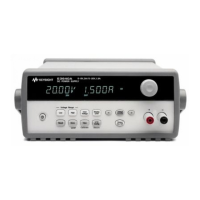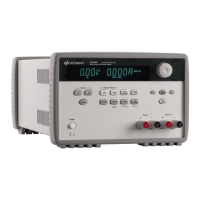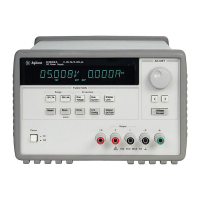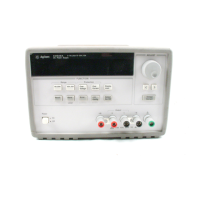Chapter 4 Remote Interface Reference
Output Setting and Operation Commands
86
CURRent:STEP? [DEFault]
Return the value of the step size currently specified. The returned parameter is a
numeric value. ‘‘DEFault’’ gives the minimum resolution of the step size in unit of
amps.
CURRent:TRIGgered {<current>| MINimum | MAXimum}
Program the pending triggered current level. The pending triggered current level is a
stored value that is transferred to the output terminals when a trigger occurs. A pending
triggered level is not affected by subsequent CURRent commands.
CURRent:TRIGgered? [MINimum | MAXimum]
Query the triggered current level presently programmed. If no triggered level is
programmed, the CURRent level is returned.
Example The following program segments show how to use the CURR UP or CURR DOWN
command to increase or decrease the output current with the CURR:STEP command.
‘‘CURR:STEP 0.01’’ Set the step size to 0.01 A
‘‘CURR UP’’ Increase the output current
‘‘CURR:STEP 0.02’’ Set the step size to 0.02 A
‘‘CURR DOWN’’ Decrease the output current
INSTrument[:SELect] {OUTPut1 | OUTPut2 | OUT1 | OUT2}
Select the output to be programmed one of the two outputs by the output identifier.
The outputs of the power supply are considered as two logical instruments. The
INSTrument command provides a mechanism to identify and select an output.
When one output is selected, the other output is unavailable for programming until
selected. The commands which are affected by the INSTrument command are
output setting command (SOURce), measurement command (MEASure), and
calibration command (CALibration).
INSTrument[:SELect]?
Return the currently selected output by the INSTrument{:SELect] or
INSTrument:NSELect command. The returned value is ‘‘OUTP1’’ or ‘‘OUTP2’’.
INSTrument:NSELect {1 | 2}
Select the output to be programmed one of the two outputs by a numeric value instead
of the output identifier used in the INSTrument:NSELect or
INSTrument[:SELect] command. ‘‘1’’ selects output1, and ‘‘2’’ selects
output2.

